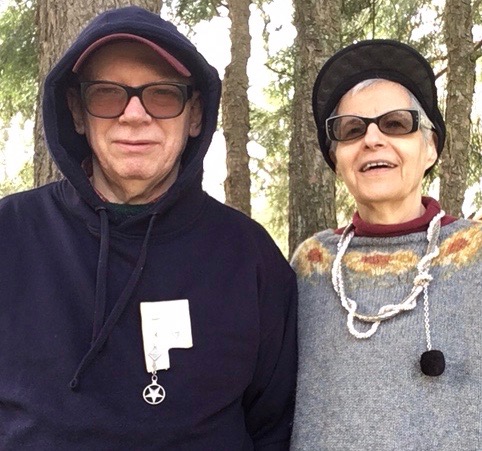Miriam Bloom & Ron Morosan
Colette Copeland
May 2020
The sixth in a series of conversations with artist couples delving into how they are
surviving the pandemic times.
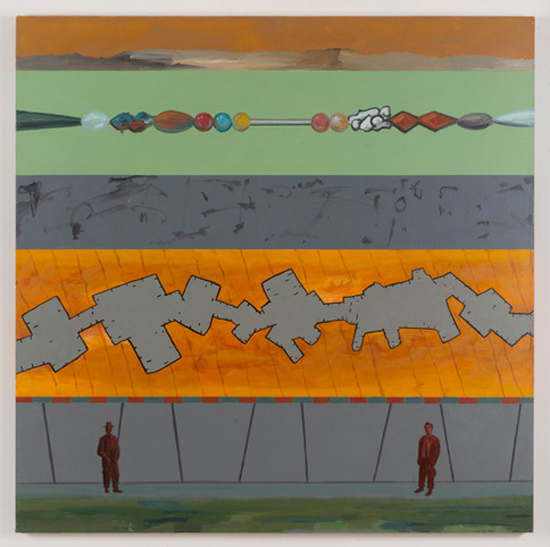 Ron Morosan, Dual Quad Rational, 2017, acrylic on canvas
Ron Morosan, Dual Quad Rational, 2017, acrylic on canvas
Email conversation with artists Ron Morosan and Miriam Bloom.
CC: How has covid19 and the quarantine impacted your artistic practice both conceptually and technically?
RM: The quarantine has definitely curtailed what I was working on in my studio in New York City. I had a couple of large canvases that I was just starting, but then Covid hit and everything stopped. We decided to move to our house and studio upstate, which is roomy with two floors and a decent amount of space. I concentrate on drawings and have begun a couple of smaller scale paintings. It’s a challenge to find materials. I’ve been using what I have around the house and improvising with new materials. I like this approach and new ideas are developing, but I feel held back from what I want to do.
MB: Because we left our NYC studios very quickly with just backpacks, my large sculptures, some in process for years, could not be brought with us to finish. Alternative processes are now being explored. These include editing photos that have been taken over the last 20 years, many based on artworks that are loved, contemporary and historic. I am planning videos that relate to sculpture as well as short videos that Ron and I have outlined to do together. I am also working on small models for sculptures. Materials for sculpture are whatever is available in the house rather than purchasing anything new. This approach forces me to think in new ways. Louise Bourgeois used that approach in much of her later work. Her button collages, hanging figures made out of towels, and large installations are examples of that attitude in practice. Japanese Boro cloth is another inspiration.
This has been a time of contemplation and intense life review.
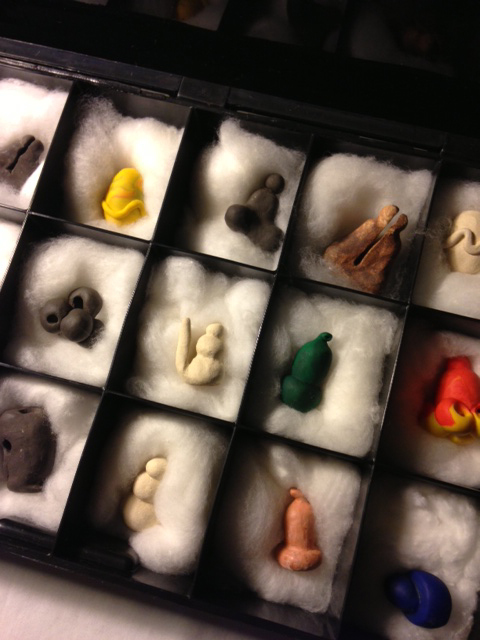 Miriam Bloom, miniature sculptures, 2020, clay & mixed media
Miriam Bloom, miniature sculptures, 2020, clay & mixed media
CC: Speak about your decision to leave New York and shelter in upstate.
RM: Miriam was following the news about the virus very closely and became more and more alarmed at the speed of its spread. By mid-March, we were both convinced we had to get out of the city and move to upstate New York where the number of cases was zero at the time.
MB: In February, paying attention to epidemiologists and science writers, Donald McNeil in particular, convinced us that the virus would be an unprecedented event and that we would have to leave New York City for the duration especially because we are in the high risk group. We moved to our summer studio in a house in the small upstate village of Deposit, NY on March 11.
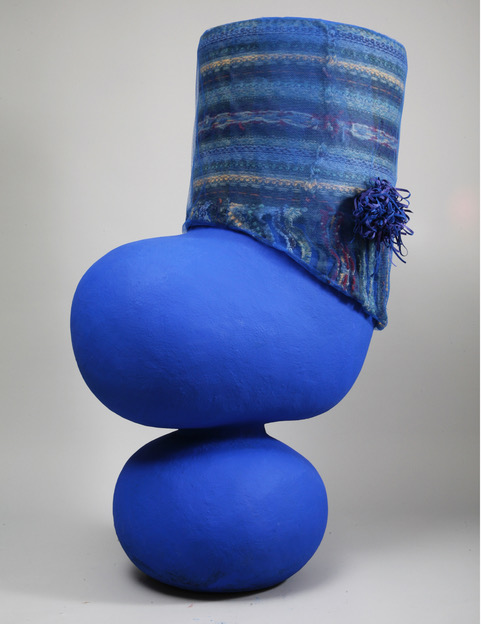 Miriam Bloom, Clouds and Sand, 2010, mixed media
Miriam Bloom, Clouds and Sand, 2010, mixed media
CC: What’s been the most challenging part of the quarantine for you?
RM: Last fall we had a huge exhibition at the Westwood Gallery, New York with a terrific catalogue, so we were very high on the positive things happening. This was the first time Miriam and I had shown together in New York City and everything went very well. So, having to be out of the city for an indefinite period is very disruptive. In a sense, the art world of NYC Is out of commission as a scene. Now it’s online which is very strange and remote.
Being in quarantine is not really a problem. Working is what we do in a studio and staying put is part of the process. I can text people and call on the telephone, so keeping in touch is relatively easy. But, of course the art scene in the city was so active that all that input is now on hold. (I find myself having dreams about the New York art world. Just the other night I had a dream I was going into the New Museum and it was very crowded and people were hugging each other.)
MB: All inconveniences are minor amidst the suffering worldwide. However, there are waves of great sadness over lives lost and the crisis being handled terribly and the horrendous consequences resulting. Two friends have died. There is no opportunity to grieve together in person as a community.
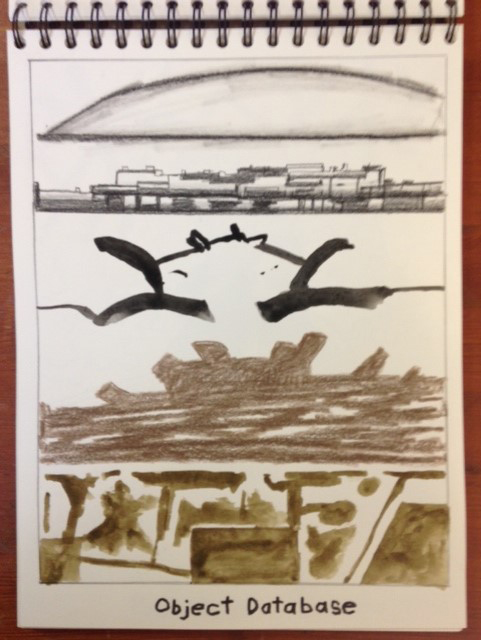 Ron Morosan , Object Database, 2020, mixed media on paper
Ron Morosan , Object Database, 2020, mixed media on paper
CC: What are your strategies for staying sane and not getting on your partner’s nerves during these times?
RM: Miriam and I have been together for a long time and are accustomed to each other’s work time and need for personal space and time. But we are now collaborating on a series of three videos dealing with our time here and the house we are occupying. One video will deal with the house which is somewhat of an art work in itself. It is a very old house build in 1839 and has a lot of nice interior features. We’ve been transforming it into an art house with our own art and the art we’ve collected from our friends and colleagues. The other videos are still in the script stage; Miriam is the conceptual and technical brain working out the scenes and subjects to shoot.
MB: Strategies for staying sane are: being in touch with friends, doing artwork, reading cherished books, listening to music–Mozart in particular, keeping order in the house, preparing healthy meals, yardwork, exercising, and taking online classes. Ron is a marvelous companion. So grateful we are together through what may be over two years in this situation. I always feel like Anne Bancroft who said when Mel Brooks walked through the door, “Let the party begin!”
Colette Copeland with Mary Magsamen & Stephan Hillerbrand →
Colette Copeland with Francesca Leoni & Davide Mastrangelo →
Colette Copeland with The Brians a.k.a. Chuck & George →
Colette Copeland with Ryder Richards & Sue Anne Rische →
Colette Copeland with Silvia Argiolas & Matteo Campulla →
Ron Morosan: As biographies go, I could be described as a poly-conceptual artist: that is, I’m theoretically complex and difficult to describe. I like this, and I’ve been honored with opportunities to exhibit in the Venice Biennale, the New Museum, and numerous galleries in Europe. I also write about art and have even ventured into the realm of gallerist when I opened an experimental gallery in 1990 called B4A. After four years I moved on to more intense work in my studio and shows in Europe. Today I’m happily associated with the Westwood Gallery in New York and looking forward to more projects with them.
Miriam Bloom: We moved to New York City in 1975 and have had studios and exhibitions there for the past 45 years. It has been a privilege to visit artist friends’ studios and see their development first hand. In 1977, my work was first exhibited at the Jock Truman Gallery, an offshoot of the Betty Parsons Gallery. I have had exhibitions at the Baltimore Museum of Art, The DePaul Art Museum, the Islip Museum, and internationally. Delighted to now be represented by the Westwood Gallery, New York.
Colette Copeland is a multimedia visual artist/writer whose work examines gender, death and contemporary culture. Sourcing personal narratives and popular media, she uses video, performance and installation to question societal roles and media’s influence on enculturation. Her experimental videos employ absurdist humor to explore the landscape of human relationships. She loves all things Dada and Fluxus with a big splash of subversive humor. Ron has inspired me to meditate on my inner poly-conceptual artistic nature.

